
| Book Title | Arab Conquests Of Central Asia |
| Book Author | Gibb |
| Total Pages | 122 |
| Book Views | |
| Language | English |
| Book Download | PDF Direct Download Link |
Arab conquests of central Asia
ARAB CONQUESTS OF CENTRAL ASIA
The author says: The early Arabic sources are remarkably rich in material for the reconstruction of the conquests in Khurāsān and Transoxania.
For the earlier period the narratives of Ya’qūbi and Balādhuri are nearly as full as those of Tabarī, but the special value of the latter lies in his method of compilation which renders the traditions amenable to critical study and thus provides a control for all the others.
Moreover, while the other historians, regarding the conquests of Qutayba as definitely complet ing the reduction of Transoxania, provide only meagre notices for the later period, Tabarī more than compen sates for their silence by the enormous wealth of detail embodied in the accounts he quotes from Al-Madā’ini and others of the last thirty years of Umayyad rule.
As a general rule, these three historians rely on different authorities, though all use the earlier histories of Al Madā’ini and Abū ‘Ubayda to some extent.
The monograph of Narshakhi (d. 959 A.D.) based on both Arabic and local sources, with some resemblance to Balādhuri, is unfortunately preserved only in a Persian version of two centuries later which has obviously been edited, to what extent is unknown, but which probably represents the original as unsatisfactorily as Bal’ami’s Persian version of Tabari.
Even so it preserves to us some account of the peoples against whom the Arab invaders were matched, and thus does a little to remedy the defects of the other historians in this respect.
It may well be doubted, however, whether some of its narratives merit the reliance placed upon them by van Vloten (17).
The much later historian Ibn al-Athir intro duces very little new material, but confines himself for the most part to abridging and re-editing the narratives in Tabari, with a tendency to follow the more exaggerated accounts.
The geographer Ibn Khurdādhbih gives a list of titles and names, which is, however, too confused to supply any reliable evidence.
Reference has already been made to certain aspects of the conquests in which the Arab historians are misleading.
Their information on the Turks and the principalities of Sogdiana can now, fortunately, be supplemented and parts of their narratives controlled from Chinese sources, chiefly through Chavannes’ valuable “Documents sur les Tou-Kiue (Turcs) Occidentaux.” But there are two other facts which also demand attention:
one, that the Arabic authorities, as we possess them, and even with all allowance made for their limitations, are by no means exhaustive; i.e., reliance on omissions in the narratives is an unsafe principle of criticism:
the other, that by critical study it is possible to distinguish at certain points several lines of tendentious tradition or legend, directed to the interests of national feeling or of some particular tribe or faction, and centred in some cases round specific persons.
These may most conveniently be summarised as follows:
1. A Qaysite tradition, centred on the family of Ibn Khāzim :
2. An Azd-Rabī’a tradition, centred on Muhallab and hostile to Hajjāj. This became the most popular tradition among the Arabs, and is followed by Balādhuri, but opposed by Ya’qūbi :
3. A Bāhilite tradition, centred on the tribal hero, Qutayba b. Muslim.
In general, it found little favour but is occasionally quoted somewhat sarcastically by Tabarī.
4. A local Bukhārā tradition, followed by Ya’qūbi, Balādhurī and Narshakhi. It presents the early conquests under the form of an historical romance, centred on the Queen Khātün in the part of a national Boadicea. Other local traditions, which are frequently utilised by Tabari, seem to be much more free from serious exaggeration
The few notices in Dīnawari follow an entirely divergent and extremely garbled tradition from unknown sources, which may for the most part be neglected:
The quotations made by Balādhuri (e.g. 422, 10) from Abū ‘Ubayda show the influence of a re writing of episodes with an anti-Arab bias, directed to the interests of the Shu‘ūbīya move ment, in which Abū ‘Ubayda was a prominent figure (18). 7.
In the later period, there appears also the fragments of a tradition of which Nasr b. Sayyār is the hero. Some, if not all, of these traditions developed in some detail, and where they are not balanced by other versions they present a distorted narrative of events, verging in some cases on the fictitious.
The most noteworthy examples of this are the Khātün legend (see below p. 18) and the typical story of the exploits of Mūsā b. Khāzim in Transoxania in a style not unworthy of Bedouin romance (19).
It is therefore most important to dis entangle these variant traditions and assign its proper value to each.
The Bāhilite accounts of Qutayba’s conquests, for instance, contain wild exaggerations of fact, which, nevertheless, have sometimes been utilised in all seriousness by modern historians, amonst other purposes to establish synchronisms with the Turkish inscriptions (20). With these precautions, it is possible to follow up and reconstruct, with comparative certainty and completeness
To read more about the Arab Conquests Of Central Asia book Click the download button below to get it for free